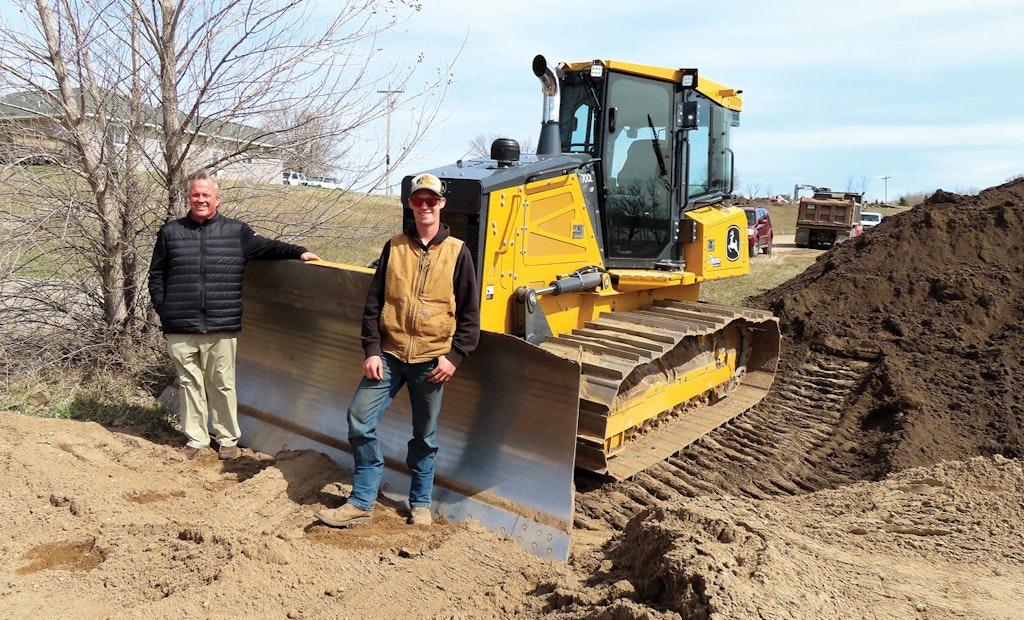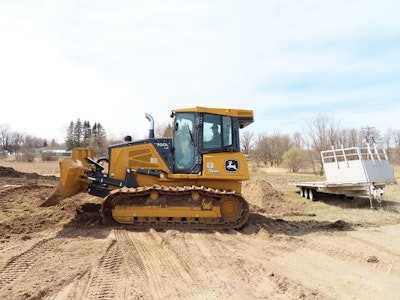
Vern Schnathorst, left, the work-based learning coordinator for Detroit Lakes High School in Minnesota, and student Jaden Thorson are shown on a work site with a John Deere 700L crawler dozer. (Photos provided by Vern Schnathorst)
It’s the biggest industry concern I hear from installers.
“I’m so busy and I just can’t find any good, young workers.” It’s no exaggeration to say that this complaint is shared with me every month (and probably more often) from contractors who are constantly pushing work back on their schedule for lack of enough help.
The message permeates the feature articles in this magazine, too. This month is a good example. The contractor in our profile story, Joe Bruening, downsized his company and looked for a new way to remain in business because he couldn’t find workers with a passion for system installing. And in our Snapshot story, a Wisconsin Onsite Water Recycling Association member identified a shortage of workers as the biggest issue facing the state’s installers.
Magnifying the seriousness of a labor shortage is the well-known graying of folks who lead excavation companies and operate machinery. We know a tremendous number of installers are reaching retirement age, and they’re wondering where the young people are coming up to continue this vital construction work.
There is also a constant drumbeat from the trades that not enough emphasis is being placed on tech schools and the value of jobs that require physical labor. It is often said in these circles that too many high school students are being directed toward four-year college degrees and away from careers related to building and rebuilding our infrastructure — pursuits like welding, electrical, plumbing and the work of our wastewater professionals.
I believe that drumbeat is starting to be heard. A new emphasis in teaching for employability at a small school district in Northwest Minnesota is an example that should give hope to our overburdened community. And, specifically, talking to a student who is training to become an installer will show you that the labor situation may not be quite as dire as you think.
Good things happening
Jaden Thorson, 18, earned most of his required credits early at Detroit Lakes High School, located about an hour east of Fargo, North Dakota. He has been involved in an internship program to explore options in the trades right in his hometown. During the fall 2020 semester, he learned welding and custom fabrication at one company that partners with the school. This spring, he honed his machine operator skills with an onsite installing company, and then started working full-time after graduation.
The first experience was the result of a partnership between the school, the business and the Minnesota Department of Labor, which awarded a grant to the school for training in three areas of need: advanced manufacturing, plant science and greenhouse management and a certified nursing assistant program. The second internship was through the school’s work-based learning program.
The encouraging news for those who want to see more emphasis on job training is that the high school is moving from a college-prep emphasis to an “academy” model program in 2021-22. This means students from freshman year on will be exposed to a variety of careers with in-demand jobs found close to home, says Vern Schnathorst, the work-based learning coordinator for the school district.
It’s not that students will be discouraged from higher education options, Schnathorst says. But he says there has long been a mindset that most students should aspire to a college degree even if that wasn’t the best choice for many of them. Now the goal is to identify students’ interests and aptitudes early and present them with career choices, and he believes the trades are the best choice for many students in Detroit Lakes.
In years past, about 65% of students went on to some form of higher education, close to the state average, Schnathorst says. But the majority of jobs in Minnesota do not require a four-year degree, meaning that many students have been overeducated for the positions they end up taking after school. As he explained it, the school was always good at serving the top 20% and bottom 20% of students, while not helping the middle 60% find meaningful workplace experience.
“People were conditioned to think that if you didn’t go to a four-year college, you weren’t successful. And that’s not the case,” Schnathorst says. “We’re helping parents and students understand there are tons of good options for worthwhile careers that have a lot of nobility in them that don’t require a four-year degree.”
Job site experience
Parents often wrongly assume that the trades are a less lucrative career for their students, according to Schnathorst. “They forget to look at the bill when they hire a plumber or an electrician,” he says.
When students find the appropriate career training path, they will all benefit financially and with upward mobility, he says. For example, a student who starts working in a trade after high school may earn $15 an hour and in four years be making $25 per hour with a good company, Schnathorst explains. Too many college grads leave school with student-loan debt and find they are underemployed because they are not trained for skills required in their region, he says.
Under the new model at Detroit Lakes, all students will be exposed to career paths that reflect their interests and aptitude for work. Freshman activities will include guest speakers from the community and a career fair and expo that will help them choose a pathway for sophomore year. As sophomores they will take industry-related field trips, and as juniors they will job shadow with a professional. As seniors, one semester will include an internship in the community.
While some pathways focus on careers requiring four-year degrees, the “production” pathway will be a choice for students interested in trades like metal fabrication, small engines and agriculture. During senior internships, the students will be graded on weekly workplace learning reports and must meet strict attendance and punctuality requirements. They are there to learn the expectations in a professional workplace, Schnathorst says.
“We’ve conditioned kids to think they’re perfect and have no flaws. It’s important to learn what you’re not good at and have the opportunity to learn and improve,” he explains. “You’re not a professional employee yet. We expect failures and that’s OK as long as you learn from it and get better.”
A go-getter
Thorson grew up with role models in the onsite installing industry. He was eight or 10 years old when he started practicing with his grandfather Nels Thorson’s excavators and started working more officially for Nels Thorson Excavating at age 15. His father, Dan Thorson, owns Thorson Septic Design. So it was a natural progression to sign on for an internship with Colin Metry, owner of Metry Septic and Excavating, where he expects to lead his own installing crew now that he’s graduated.
Thorson says it’s valuable experience to work on a variety of equipment for Metry Septic, including excavators, loaders, skid-steers and bulldozers. The majority of the company’s work is in septic system installation, but the crew also clears land, digs out stumps, levels off pads for houses and driveways, and even does sewer and water work.
“This is probably one of the best ways I could get experience, working for somebody else. It’s really cool just being able to use all this equipment,” he says. Working for someone outside his family’s businesses is a key to the program, according to Schnathorst. That’s one of the internship requirements; students must work outside of a family business to learn how others conduct business.
Thorson says the intern experience has confirmed what he always wanted for a career.
“I think I’m doing pretty good for myself right now, but I know I have a lot of room to grow. The more experience you have, the more people are going to be willing to pay for it. People are telling me what I’m worth now and what I’ll be worth in 15 years. It’s motivating to know there are a lot greater things coming for me. I just have to keep getting up and working for it.”
Thorson sees the aging of the onsite industry at a time when their services remain in high demand. This creates an opportunity for young people who want to work hard. “There are a lot of older guys getting ready to retire around here, and I just see that as more work for me to do and I don’t think that’s a bad thing,” he says.
Thorson recognizes that he’s in a small minority of classmates who rise and go to work before the rest of the class heads off to school. Fostering a work ethic might be the biggest impediment to students being prepared to work in the trades, he says.
“It’s crazy, young people just don’t want to work anymore. People are paying good money right now for kids to come out and help, but nobody wants to get their hands dirty,” he says. When he talks to other students about job opportunities, the first question they ask is, “‘How much do I get paid?’ I don’t know if that needs to be the most important thing. Kids don’t see the opportunity that’s there right in front of them.”
It's a long haul
Maybe Thorson can be part of the solution to raising awareness about the trades, Schnathorst says. He hopes the young excavator will come back to share that message of opportunity and hard work with younger students coming up. But progress isn’t going to happen overnight, he says.
“Hopefully we’ll start to make some progress toward this labor shortage. It’s not a one-year fix; it’s going to take a 10-year commitment,” he says. While probably only 10% of Minnesota school districts have a work-based learning coordinator position, Schnathorst is starting to see more following suit.
And that’s a good thing.
Learning about the strides being made in Detroit Lakes and talking to Thorson is a great counter balance to the pessimism our installing community rightfully feels these days. We should foster similar programs in our own hometowns to promote the value of working in the trades. We all have an important role to play in school-to-work programs as a way to bolster the ranks of quality workers in our industry. The future and so many young students depend on us.






